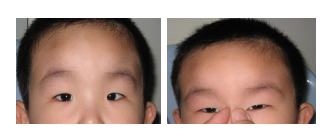Download and print as a PDF (625kB pdf)
On this page
This information is intended to answer some of the questions of carers of children diagnosed with pseudostrabismus under the care of University Hospitals Sussex NHS Foundation Trust.
What is Pseudostrabismus?
Strabismus is the term used to describe eyes that are not pointing in the same direction and not working together. Pseudostrabismus refers to a false appearance of a squint.
The eye may appear to turn inwards, outwards or both eyes may not look as if they move together, but the eyes are actually straight.
What will I notice?
When you look at your child, it may look as if one of their eyes is turning inwards or outwards, but the eyes are in fact straight. Most often, the appearance is of an eye turning inwards. This is typical of strabismus that is only seen in photographs or when the child is looking to one side.
What should I look for?
If you shine a light on your child’s eyes, you will be able to see a reflection on the front surface of the pupils (black part in the middle of each eye).
If the eyes are straight, the light reflection will be in the same place in each eye.
If there is a strabismus, the reflections will be in a different place in each eye.

It is useful to look at photos which may demonstrate this.
What causes it?
It is caused by a child’s facial appearance. This may be due to the wide, flat bridge of the nose, and / or excess of or prominent skin folds, known as epicanthus, around the nose or the distance between the eyes. This results in a portion of the eye being hidden, creating the impression that one eye is turned in towards the nose. Sometimes the shape of the face / eyes may add to this appearance e.g. different coloured eyes or asymmetrical eyelid positions.
A pseudoesotropia is where the eye appears to be turning inwards and may be due to a wide bridge of the nose and / or a small distance between the eyes.
A pseudoexotropia is where the eye appears to be turning outwards due to widely set eyes and / or wide bridge of the nose.
What is the importance of differentiating between pseudostrabismus and true strabismus?
True strabismus in a child can lead to reduced vision and loss of binocular function, i.e. not using the eyes as a pair. Pseudostrabismus will not cause any harm.
Is it common?
Yes, many children have pseudostrabismus.
How do you test for it?
This can be carried out by the orthoptist who will check your child’s vision by testing the sight of each eye in turn and by looking at how well the eyes are used together. Just because your child has had a pseudostrabismus does not mean that they can never develop a true strabismus. However, they are not any more likely to develop a true strabismus than the rest of the population.
The orthoptist will advise that your child be tested periodically to ensure normal development.
What is the treatment?
No treatment is necessary. As your child grows the bridge of the nose will develop and the pseudostrabismus will become less apparent.
In some face shapes, genetic conditions and ethnicities the bridge of the nose may remain broad into adulthood, meaning the eyes may continue to appear slightly asymmetrical. This will not cause any problems.

Contact details
St Richard’s Hospital
St Richard’s Hospital
Spitalfield Lane
Chichester
West Sussex
PO19 6SE
Orthoptist
01243 831499
Southlands Hospital
Southlands Hospital
Upper Shoreham Road
Shoreham-by-Sea
West Sussex
BN43 6TQ
Orthoptist
01273 446077
The information here is for guidance purposes only and is in no way intended to replace professional clinical advice by a qualified practitioner.